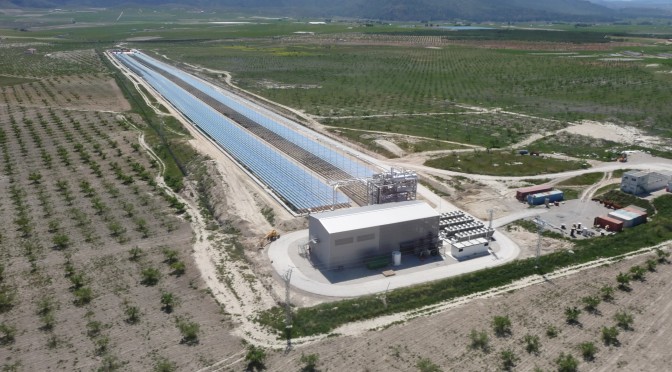In the south of Spain, a novel solar plant backed by five Swiss electricity companies is beginning commercial operations after a lengthy test phase, with plans to provide power to up to 12,000 households.
Four rivers, two marshes, rice paddies, almond trees, farms and small businesses: the town of Calasparra is removed from the usual tourist haunts in this part of the country, 100 kilometres west of Alicante. Far from rainy Switzerland, the July sun is high in the sky and the temperature hovers around 32 degrees Celsius.
For most people, these are ideal conditions for generating solar power. Not so for Swiss engineer Leo Voser, technical director of the Puerto Errado 2 project. He points at what seems to be a harmless cloud hiding the sun. “If there are a lot of clouds in the sky, we can shut down our installation,” he says. The backbone of the so-called Fresnel facility, the biggest of its kind, is 300,000 square metres of mirrors spread out over 28 rows, each 940 metres long. Split into two separate fields, the mirrors are positioned in such a way that with enough sunlight, they can each generate sufficient steam to keep one of two 15-megawatt turbines ticking over. The mirrors concentrate the sunlight upwards onto a tube containing water, part of a high-pressure circuit. The sunbeams heat the tube and the water inside, transforming it into steam that should ideally reach a temperature of 270 degrees Celsius as part of the process. The steam is then fed into the turbine, much along the lines of a conventional thermal power plant, completing the transformation into electricity. The steam is then cooled and the resulting water fed back into the circuit.
System limitations
“When clouds appear, this means less sunlight on the mirrors and less energy focusing on the steam tube, so we cannot reach 270 degrees,” says Voser. “This means there is less or no steam available, leading to lower pressure and forcing us to switch off both turbines.” In winter, when the sun is lower on the horizon, there is also less power available for electricity generation. “At that time of the year, we can only use one turbine even if both fields are operational,” admits the technical director. At best, output can only reach 15 megawatts, instead of the maximum 30. And only during daylight hours. “It’s surprising as well how sensitive the system is to clouds or to haze, as we often have in summer,” adds Voser. The facility can produce power around 2,000 hours per year – a quarter of the time traditional gas, oil or coal-burning thermal plants can operate. This limited operation is compensated by falling costs for solar equipment and higher prices for solar-based electricity. Voser says the biggest challenge is the fine tuning of the plant, more specifically keeping the turbines supplied with a steady flow of steam to keep them running. “If you heat the steam with oil or gas, all you have to do is switch it on and it looks after itself,” he told swissinfo.ch.
Price subsidies
The variations in steam pressure led to unexpected problems during testing, with piping and turbines affected by the changes. Those problems appeared in the conventional sections of the facility, where, according to the technical director, everything should have functioned without any trouble since they were made up of standard elements that had been used for years elsewhere. In the newer section, there were actually fewer problems than expected. “The solar field is surprisingly reliable and robust even though it may appear fragile,” says Moser. Since February, the facility has been connected to the local grid. The Spanish-registered company that owns it can sell electricity at a competitive €0.36 per kilowatt-hour, a price that is low thanks to government subsidies for solar power. That price along with plentiful sunlight and cheap land were among the criteria that convinced Swiss power company EBL and its partners to build the plant and gain experience with large-scale renewable energy projects. When commercial operations begin at the end of July, another Spanish company will be responsible for operating and maintaining the site. “In Switzerland, you couldn’t build a plant this size,” says Voser. “You can only produce electricity from solar energy within a certain framework.” “But building here was a risk too. New technologies are always risky.”
Andreas Keiser in Calasparra, swissinfo.ch, http://www.swissinfo.ch/


